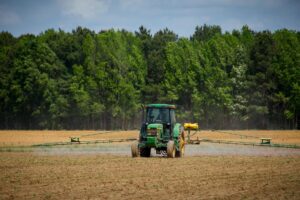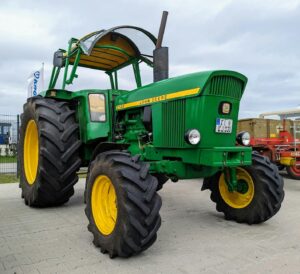Choosing the right tractor is crucial for improving efficiency, productivity, and overall ease of operation on your farm, property, or construction site. With so many models available, selecting the best one can be overwhelming. Whether you need a compact tractor for landscaping, a utility tractor for farming, or a heavy-duty model for construction, this guide will help you make an informed decision.
How to Choose the Right Tractor
1. Determine Your Tractor’s Primary Use
The first step in choosing a tractor is identifying what tasks you’ll be using it for. Different tractors are designed for different applications, including:
🚜 For Farming & Agriculture:
- Plowing, tilling, and planting
- Hay production and baling
- Heavy-duty land clearing
✔️ Recommended Tractors: Utility or row-crop tractors with at least 40–100+ HP.
🌿 For Landscaping & Gardening:
- Mowing large lawns
- Tilling garden beds
- Moving soil and mulch
✔️ Recommended Tractors: Compact or sub-compact tractors with 18–35 HP.
🏗️ For Construction & Heavy Work:
- Excavation and trenching
- Lifting heavy materials
- Grading and leveling land
✔️ Recommended Tractors: Industrial or backhoe loaders with 50+ HP.
❄️ For Property Maintenance & Snow Removal:
- Clearing driveways and roads
- Hauling firewood
- Light tilling and land grading
✔️ Recommended Tractors: Compact or mid-size utility tractors with 20–50 HP.
2. Understand Horsepower (HP) Requirements
Horsepower determines how powerful a tractor is and what kind of tasks it can handle.
Tractor HP Ranges and Uses:
- 15–25 HP – Ideal for mowing, gardening, small property maintenance. (e.g., Kubota BX Series, John Deere 1 Series)
- 25–50 HP – Great for small farms, landscaping, and hauling loads. (e.g., Kubota L Series, John Deere 3 Series)
- 50–100 HP – Best for medium-sized farms and livestock operations. (e.g., John Deere 5 Series, Kubota M Series)
- 100+ HP – Required for commercial agriculture, large-scale construction, and industrial applications. (e.g., Case IH Magnum, John Deere 8R Series)
🔹 Tip: Choose a tractor with at least 10–20% more HP than your estimated needs to ensure efficiency and adaptability for future tasks.
3. Consider the Right Transmission Type
The type of transmission impacts the ease of use, control, and efficiency of the tractor.
🚜 Gear-Driven Transmission (Manual)
✔️ Best for: Heavy-duty tasks, plowing, long working hours ✔️ Offers precise speed control and durability ✔️ More affordable but requires manual shifting
🔄 Hydrostatic Transmission (Automatic-Like)
✔️ Best for: Landscaping, mowing, loader work ✔️ Easier to operate (similar to driving a car) ✔️ Slightly less efficient in fuel consumption but offers smooth speed adjustments
⚙️ Power Shuttle Transmission (Semi-Automatic)
✔️ Best for: Front-loader work, frequent reversing ✔️ Allows smooth shifting without clutching ✔️ Great for construction and material handling
🔹 Tip: If you’re a beginner, hydrostatic transmission is the easiest to operate. For experienced users, gear-driven or power shuttle transmissions provide more power efficiency.
4. Choose Between 2WD vs. 4WD
The terrain and workload determine whether you need 2WD (Two-Wheel Drive) or 4WD (Four-Wheel Drive).
🚜 2WD Tractors
✔️ Cheaper and more fuel-efficient ✔️ Best for flat terrain and dry conditions ✔️ Suitable for mowing and light-duty farming
🌧️ 4WD Tractors
✔️ Provides better traction in mud, snow, and uneven terrain ✔️ Required for heavy loads, plowing, and rough conditions ✔️ More expensive but necessary for challenging environments
🔹 Tip: If you work on hilly land or in wet conditions, go for a 4WD tractor for better traction and stability.
5. Pick the Right Attachments & Implements
A tractor’s versatility depends on its compatibility with different attachments and implements. Consider what tools you’ll need:
🌿 Lawn & Landscaping:
- Mower deck
- Front-end loader
- Box blade or grader
🌾 Farming & Agriculture:
- Plow or tiller
- Seeder or fertilizer spreader
- Bale loader
🏗️ Construction & Heavy Work:
- Backhoe attachment
- Pallet forks
- Post-hole digger
🔹 Tip: Check if the tractor has a Category 1 or 2 three-point hitch for implement compatibility.
6. Evaluate Comfort & Safety Features
A comfortable tractor ensures less fatigue and better productivity during long work hours. Look for:
✔️ Ergonomic seating with suspension ✔️ Power steering for easy maneuverability ✔️ Enclosed cab with AC/heat (for harsh weather conditions) ✔️ ROPS (Rollover Protection System) for added safety
🔹 Tip: Test drive different models to see which feels most comfortable for your height and body posture.
7. Consider Fuel Efficiency & Maintenance Costs
Tractors are a long-term investment, so it’s important to consider:
💰 Fuel Type & Efficiency – Diesel tractors are more fuel-efficient than gasoline models. 🔧 Maintenance & Repairs – Check for easy access to the engine, oil filters, and hydraulic systems. 🛠️ Warranty & Dealer Support – Opt for brands with strong customer service and readily available parts.
🔹 Tip: Kubota, John Deere, and New Holland are known for low maintenance costs and excellent dealer support.
8. Set Your Budget & Compare Brands
Tractor prices vary widely depending on brand, horsepower, and features.
💲 General Price Ranges:
- Sub-Compact Tractors (15–25 HP): $10,000 – $20,000
- Compact Tractors (25–50 HP): $20,000 – $35,000
- Utility Tractors (50–100 HP): $35,000 – $80,000
- Large-Scale Farm Tractors (100+ HP): $80,000 – $250,000+
🔝 Top Tractor Brands to Consider:
- Kubota – Best for compact and utility tractors
- John Deere – Best for reliability and high resale value
- New Holland – Best for fuel efficiency and affordability
- Case IH – Best for large-scale farming
- Massey Ferguson – Best for versatile use and rugged build
🔹 Tip: Look for used tractors from reputable dealers if you’re on a budget. Many brands offer financing options and seasonal discounts.
Final Thoughts: Choosing the Best Tractor for You
When choosing a tractor, focus on: ✅ Your specific needs (farming, landscaping, construction, etc.) ✅ Horsepower requirements (don’t underpower your work) ✅ Transmission type (manual vs. hydrostatic) ✅ 2WD vs. 4WD (consider terrain and traction) ✅ Attachment compatibility (future-proof your investment) ✅ Comfort and safety features (work long hours without strain) ✅ Budget and resale value (buy a tractor that holds its value)
A well-chosen tractor will serve you for decades with proper maintenance. If you’re still unsure which model to pick, consult a local dealer or test drive multiple tractors before making a final decision.
Need more help choosing a tractor? Drop your specific needs in the comments, and I’ll help you find the best model!




Pingback: 10 Top Tractors for Efficient Farming